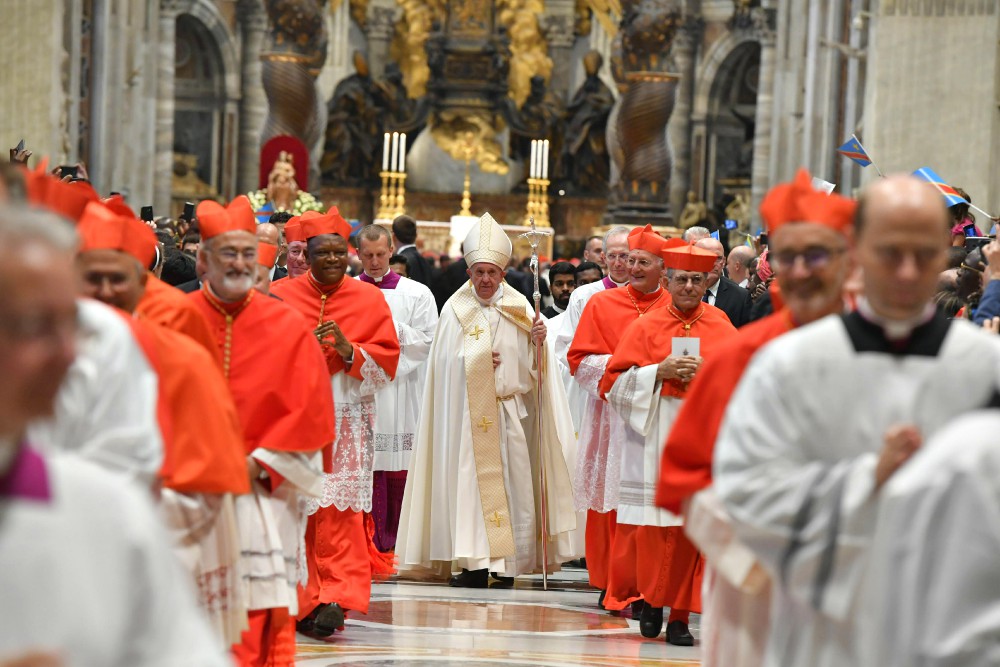
Pope Francis walks in procession with new cardinals during a consistory in St. Peter's Basilica at the Vatican Oct. 5, 2019. (CNS/Vatican Media)
The good news is 15 new cardinals seem to be on the Roman horizon. The bad news is they are all men. Yes, Francis will choose from the peripheries. Yes, he will most probably select the usual suspects — the archbishops of Washington, D.C., and Paris, for example. But a mix of major sees, elderly theologians and surprise picks is probably the best he can do right now.
Don't expect a woman's name to be on the list.
The 1917 Code of Canon Law decreed cardinals — advisers to the pope and electors of his successor — must be "at least" priests. The 1983 code added they "must receive episcopal ordination" if not already bishops (Canon 351.1).
Not every cardinal-designate is already a bishop — Jesuit Cardinal Michael Czerny is a recent exception — but usually only elderly priest theologians join the college of cardinals. Usually more than 80 years old, they are not invited to papal conclaves.
It does not have to be that way. To begin with, there are three ranks of cardinal: cardinal-deacon, cardinal-priest, cardinal-bishop. Theoretically, at least, a deacon or even a lay man (or woman?) can be named cardinal. The last cardinal-deacon who never became a priest or bishop, Teodolfo Mertel, was a layman when named. Pope Pius IX ordained him a deacon two months after naming him a cardinal. Mertel died in 1899. In 1917, Pope Benedict XV changed the rules, but they can be waived.
Even so, while the Holy Father's closest advisers, the six (down from nine) members of the Council of Cardinals could likely use a boost in membership to replace the three whom he removed — Australian George Pell, Chilean Francisco Javier Errázuriz Ossa, and Laurent Monsengwo Pasinya of the Democratic Republic of Congo — don't expect a deacon's voice at the table. And for sure don't expect a woman.
While the coming realignment of the Curia may bring job openings for women, it is unlikely a new dicastery head who happens to be female would be named cardinal. If they survive the changes, a few curial offices — the Congregations for Catholic Education and Causes of the Saints, as well as the Pontifical Council for Culture for example — do not need to be headed by priests or bishops. Now run by cardinals whose terms of service or retirement ages are past due, these could be headed by women.
What difference does it make? Cardinal Cristóbal López of Rabat, Morocco, said not long ago that membership in the College of Cardinals does not amount to much and offered to trade away his status.
"I give my cardinal's zucchetto, my cardinal's ring and my red cassock to the woman who wants to wear them because this gives her an illusion," he said, as two other cardinals, Juan José Omella of Barcelona, Spain, and Pedro Barreto of Huancayo, Peru, smiled in agreement.
Advertisement
Lopez's argument: Being a cardinal will not help women. "It won't add anything to who they are. If they want to be fulfilled, it's enough with them being women and being Christian."
Same old, same old.
The fact of the matter is, if you are not at the table, you are not part of the discussion. And even if you are at the table, rank has its privileges. A cardinal is a cardinal and there is a certain gravitas to his words and acts. Witness the followings of anti-Francis Cardinals Raymond Burke and Gerhard Müller.
The problem of choosing cardinals only from among bishops and priests is that the church is simply not represented by the choices, either really or symbolically. The problem of having all curial offices headed by men is the same. If the church and especially the pope depend on the voice of the Spirit for discernment, everyone needs to have a voice.
This is not to say that everyone can or should have an equal voice, but rather that more people must have the opportunity to have their points put forward for discussion. The "more people" at the bottom of the discussion tree are women, even the women who keep the church afloat.
The call for women in leadership is the call for synodality partly demonstrated by the October 2019 synod for the pan-Amazon region. Synodality means talking — and listening — to others. It does not mean making decisions in a curial echo chamber.
Even Francis' call for more lay leadership in Querida Amazonia has met with some curial pushback.
No matter if he wants to change some things now, Francis is likely to be stymied by the law. And it seems even in this pontificate law can trump prophecy.
[Phyllis Zagano is senior research associate-in-residence at Hofstra University in Hempstead, New York. She will speak at the Oct. 3 online Voice of the Faithful Conference: Visions of a Just Church.Her most recent book is Women: Icons of Christ and her other books include Women Deacons: Past, Present, Future (in Spanish as Mujeres Diaconos: Pasado, Presente, Futuro), published in France and Canada as Des femmes diacres and in Portugal as Mulheres diáconos: Passado, presente, futuro. Study Guides for these books are available for free download at https://sites.hofstra.edu/phyllis-zagano/.]
Editor's note: We can send you an email alert every time Phyllis Zagano's column, Just Catholic, is posted. Click here to sign up for email alerts.






